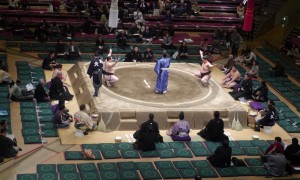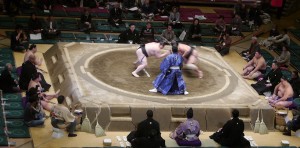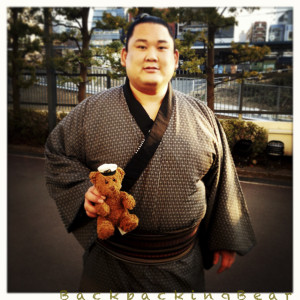Joe Louis attends a sumo wrestling match
Like most of my knowledge about things foreign, I first learned about sumo wrestling through pop culture. Yokozuna was a WWE professional wrestler in the early 1990s who had a successful career, even obtaining the highest status of World Champion. Never mind that American professional wrestling has very little in common with Japanese sumo wrestling. Yokozuna, who would enter ringside to much fanfare waving a rising sun flag, was the simplified representation of Japanese culture and sumo wrestling to the young spectator that I was. And in short, my complete understanding of sumo wrestling was that it involved very heavy Japanese men hurling themselves at each other like colliding worlds. To say that Yokozuna was a large man would be an understatement; he came in at over 500 pounds.
<
Sumo wrestling gained more U.S. popularity and press in the 90’s when Chad Rowan, a Hawaii native wrestling overseas under his Japanese moniker Akebono Taro, achieved the highest ranking in the sport – the yokozuna level. I remember reading a magazine article about the disciplined training regiment and strict dietary habits that sumo wrestlers followed in their stables. I gained a respect for them as impressive athletes, skilled gladiators who are more than just overweight men. The sport tried to gain wider global recognition by applying to be part of the Olympics, but was rejected because it was a single sex sport with no established female participation.
Most recently I heard sumo in the news for shameful reports of a match rigging scandal. In their informative book Freakanomics, Steven Levitt and Stephen Dubner describe in interesting detail how the scandal was uncovered and the incentives behind the cheating. It was a black spot on a institution known for honor in its deep rooted eastern traditions.
When I arrived in Tokyo, I learned that I had unexpectedly lucked out. Although you may be able to catch an amateur sumo match throughout the year, full professional tournaments are held six times a year. I happen to be in Tokyo during one of these 15 day tournaments and it quickly made its way onto my Must Do list. A friend at the hostel joined me and we began our journey to explore the world of sumo.

Sumo is a very big deal in Japan. Unlike football or basketball in the US, sumo dates back to ancient times and is threaded into the fabric of Japanese culture. It is has a strong connection to the country’s religious background and many of the historical traditions and rituals are still reflected in the practice today. Going to a sumo match is more than watching a sporting event, it is a look deep into the ways and heritage of an old and proud people.
Even though tournaments last two weeks and take place throughout each day, there is consistently a strong demand for tickets and prices are high. We stopped by a nearby box office where the customer agent was very helpful in explaining the ticket tiering structure. The cheapest class of ticket (I don’t know the Japanese term for nose bleed level) cannot be bought ahead of time and we were too lazy to wake up early to take a chance at buying them at the stadium the morning of. We opted for the next cheapest tier – also at the upper level and coming in at about $38 a pop. We figured the wrestlers are too big miss from any seat any way. The most expensive seats, alongside the ring, were about $117 each and weren’t actually seats but cushions on the floor. People buy sets of 4 box seats and sit barefoot on the cushions while drinking and eating. I wondered if it was a popular double date move.
The three annual Tokyo tournaments are held in Kokugigan Hall in the Ryugokan neighborhood, easily accessible by subway. There is also a nearby Sumo Museum in the neighborhood if you are interested in more history. We headed over to the arena around 2PM. The matches take place all day but the daily program is ordered according to skill class. The lower ranking competitors wrestle earlier in the day, leaving the best matches for last. More and more people trickle into the stadium as the day goes on and the competition gets noticeably fiercer.
Each individual match is more ceremonial performance than heated deathmatch. For about 15 minutes before the actual battle, the two wrestlers perform Shinto rituals that are dancelike and artistic, not what I expected from hulking fighters. The rites, including throwing salt on the ring and raising each leg high in the air, are meant to scare away demons and remove any negative presence from the ring. The fight itself usually only lasted 15 seconds as the wrestlers grappled until one person stepped out of the ring or fell to the ground. That’s a long warm up for a quick climax.
We watched the matches and tried to pick up on little details such as how the previous match’s wrestler would hand salt to the next one and how the fan-waving referees would switch after several matches. Some of the competitors were clearly fan favorites based on the uproar from the crowd, including one undersized, apparently non-Japanese fighter that got a large ovation. After all the wrestlers in a particular skill class battled, the round would end and the wrestlers all walked to the ring with sandwich boards that appeared to be advertising signs promoting local brands. It felt like a throwback boxing match.
My friend and I played a game where we predicted the winner of each match. Our expert opinions were based on the size of the warrior, the color scheme of his robe, and enthusiasm in the prematch rituals. The system actually worked pretty accurately. As expected, the later rounds were much better than the earlier ones. Some matches lasted closer to a minute as wrestlers would execute counter maneuvers to sway the balance of a grapple. It was still nerve-racking to consider how a year of training can be rendered moot in a momentary slip of the foot.
The last match of the night was the most anticipated. The equivalent of the marquee headliner. Hakuho, a reigning yokozuna, was undefeated in the tournament. He would eventually go 14-1 and win the whole tournament. He warmed up like all the other wrestlers before him, lifting his hulking frame during prematch rituals. I was excited to see him. It’s always impressive to see the best do what he does best. The match was over in a blink. Hakuho bullrushed his overwhelmed opponent and pushed him out of the ring straightaway. Still undefeated.

After the wrestling, my friend and I waited outside the arena. There was a small group of fans, mostly admiring women, cheering on sumo wrestlers as they exited the building. Many stopped to sign autographs. I noticed how sumo wrestlers wear robes and sandals even in public. As if they aren’t part of society but somehow looming outside, or even above it. The way the ladies approached them, they definitely had celebrity status. I swallowed my pride and posed for a picture.
Even after the tournament I encountered the influence of sumo. While visiting Hakuba for some fine-powdered snowboarding I ate dinner in a small, unassuming restaurant. The proprietor turned out to be a congenial former sumo wrestler who enjoyed mingling with his patrons. The walls were littered with posters of him in the ring as well as posing with what I would assume to be famous personalities. The menu was similar to his body and charm. Massive pots of various soups meant to be shared with those willing to take part.
Resources
Grand Sumo Ryogoku Kokugikan: http://www.sumo.or.jp/pdf/en/mankitsu_1405.pdf
